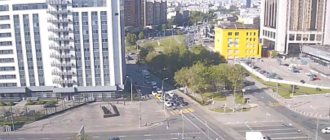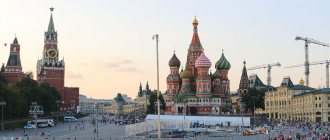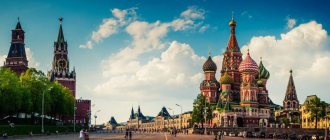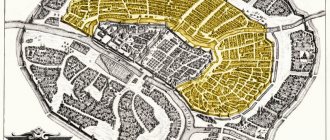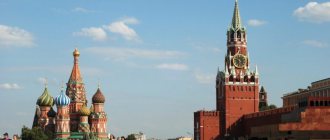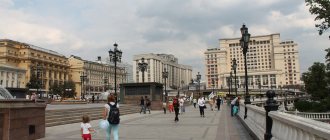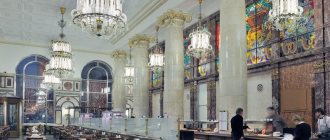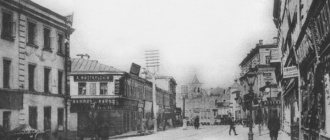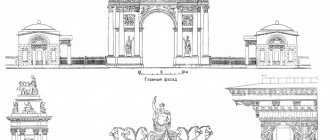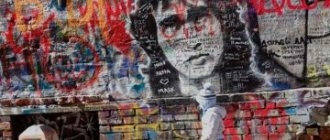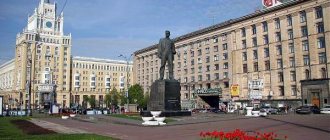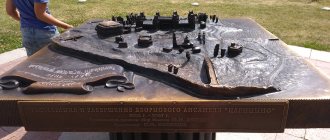A rather long section of Tverskaya Street, lying outside the Boulevard Ring, begins with two public gardens located above pedestrian crossings and three metro stations (Pushkinskaya, Tverskaya and Chekhovskaya), one of which got its name because it is located right on Pushkin Square monument to the poet.
General information about Pushkinskaya Square
The bronze monument to Pushkin by Alexander Opekushin is perhaps one of the most famous monuments in Moscow. Created with public donations and unveiled in 1880 amid solemn speeches by Ivan Turgenev and other writers, the monument was moved from its original location on the other side of Tverskaya Street to its current location in 1950.
Monument to Pushkin
Flowers always lie on a pedestal at the poet’s feet, and on Pushkin’s birthday (June 6), thousands of fans of his work gather here to read his poems aloud. Since the Russian people consider Pushkin to be the embodiment of national identity, Soviet human rights activists staged demonstrations here in the hope that the police would also be ashamed to disperse them (they were not).
Behind the Pushkin monument is the glass façade of the cinema, which was one of the first boldly conceived modern buildings in post-war Moscow; it was opened in 1961 on the site of the destroyed Passion Monastery. The cinema used to be called “Russia”, and there was a joke among Muscovites that Pushkin was standing with his back turned to Russia. But in 1997 the cinema was renamed Pushkinsky. The Moscow International Film Festivals are held here and Russian film awards equivalent to the American Oscars are presented.
Cinema "Russia" (Pushkinsky)
Located on the ground floor, the casino offers the opportunity to win cars on display outside, and there are 24-hour slot machines for avid gamblers. Behind the cinema is the building of the monthly literary magazine “New World,” which published Solzhenitsyn’s novel “One Day in the Life of Ivan Denisovich” during the Khrushchev “Thaw” era, and Orwell’s novel “1984” during the glasnost era.
The northern part of the square is blocked by the building of the Izvestia newspaper, founded as a printed organ of the Soviet government. Its previous premises were located in a 1970s constructivist building with asymmetrical balconies and round upper windows, next to the yellow-tiled Art Nouveau house, the I.D. Sytin, where the communist newspaper Pravda was published in the 1920s.
The old building of the newspaper "Izvestia"
The proximity of their location gave rise to a witty saying: “There is no news in Pravda, and there is no truth in Izvestia.” Around the corner from Sytin's house is the concrete building of another newspaper, Trud, which stands opposite the lavishly decorated Loan Treasury, a huge neo-Russian-style building that once housed the Tsar's Central Bank. At the intersection with Tverskaya there is a museum of modern history.
Creating a Square
The Tver Gate existed until 1720. At the site of their demolition, a compact platform was formed, which was decorated with a triumphal arch intended for the ceremonial entry of Peter I, who concluded the Peace of Nystadt. Subsequently, on the eve of the upcoming coronations, a new arch was erected here.
The wall of the White City was destroyed in 1770. Kuznetsov was forced out behind Zemlyanoy Val in 1784. After 11 years, the need for shops disappeared, and their owners also had to move to another place. In 1791, the Cathedral of Dmitry Thessalonica was rebuilt. In its place, a baroque temple was built, famous for its choirs.
Five years later, in the area of the dismantled wall, Tverskoy Boulevard ran, the first public promenade that Moscow received. From now on, Pushkinskaya Square will begin to transform and become a favorite promenade place.
Museum of Contemporary History
On Tverskaya Street there is a red mansion with guard houses, on the roofs of which there are stone lions; this house was mentioned in Pushkin's Eugene Onegin as the English Club - this establishment, frequented by aristocrats and pleasure-seekers in pre-revolutionary times, was converted by the Soviets into a museum of the revolution and again converted in 1998 into a museum of modern history.
There are even Soviet posters campaigning against capitalists, counter-revolutionaries and kulaks and praising collectivization and Stalin, as well as gifts and offerings to the “father of nations”, including a huge radio with a portrait of the leader. See artists' sketches for the unbuilt Palace of the Soviets, which was designed as the main building of Moscow.
Museum of Contemporary History
Cobblestones used to fend off police in 1905, an armored car used in street battles in 1917, and numbered grave markers from the Karaganda forced labor camp are among the many items on display, which is complemented by temporary exhibits on a variety of topics.
The museum ends with an exhibition recreating the library of the English Club, which was founded in 1831 and named so, although hardly a single Englishman belonged to this club. Being virtually the only place where political discussions were allowed during the reign of Nicholas I, the club soon became a “gathering of idleness”, where Leo Tolstoy lost 1000 rubles, and Mikhail Morozov lost and spent more than a million rubles in one night in the card room called "Hell".
Exhibits from the First World War
In 1913, this club hosted guests at a masquerade ball in honor of the 300th anniversary of the Romanov dynasty, which was the last major public event before the revolution. The store, located in the museum's lobby, offers Soviet posters, stamps and badges at collector's prices.
How Peter the Great erected the Triumphal Gate in Moscow
To the 400th anniversary of the Imperial House of Romanov
Now an academician, now a hero, Now a navigator, now a carpenter, He was a worker with an all-encompassing soul On the eternal throne.
A.S. Pushkin. Stanzas
Reviewing the numerous innovations boldly borrowed abroad by Peter the Great during his reign, it is impossible not to notice that they touched literally all aspects of the life of the Russian people. In fact, whether it was shaving beards or shortening kaftans, celebrating the New Year on January 1 or allowing the sale of tobacco - everything was a matter of the ebullient and energetic nature of the reformer sovereign.
So Moscow did not stand aside. One of the innovations introduced under Peter I was the construction of triumphal gates in the Mother See. The Tsar believed that the Russian Empire was no worse than the Roman Empire, where there were many such structures.
But unlike foreign customs, according to which the construction of triumphal arches was timed to coincide with a variety of occasions, in Russia these structures were erected in the event of military victories and coronations. It is interesting that in Moscow arches were mainly erected in honor of land victories, and in St. Petersburg, proclaimed the capital, in honor of sea victories.
In 1720, after the demolition of the Tverskaya Gate of the White City, a vast square was formed in its place, however, it was not empty for a long time. Already in the next year, 1721, a triumphal arch was built on it for the ceremonial entry into Moscow of Tsar Peter I, who concluded the Treaty of Nystadt with the Swedes.
In 1721, Peter I specially arrived in Moscow to make a ceremonial entry along Tverskaya Street through the triumphal gates, together with his numerous retinue. We can judge what happened almost three hundred years ago on what is now Pushkin Square from a historical document - “Reports on what was happening during the ceremonial entry of His Imperial Majesty of All-Russia into Moscow on the 18th day of December 1721,” compiled in St. Petersburg in 1722.
“When His Imperial Majesty approached the Tver triumphal gates with the Guard and other established regiments, then with a great trumpet voice, as well as kettledrums and drums and cannon fire, he was received with nationwide sympathy. And upon entering the White City, they greeted all the churches with cannon fire from the towers and towers, and all the churches with the ringing of bells.”
At the Tverskaya Gate, Peter was met by the Moscow authorities in full force: the governor-general, the governor and all “the most noble officers and other civil administrators under their command.”
The image of the Tver Gate from that time has not reached us, but thanks to the surviving description of the gate, we can imagine its solemn appearance. The description is called “Triumphal Gates in the reigning city of Moscow. To the entrance of the Tsar’s Most Sacred Majesty, the All-Russian Emperor, the Father of the Fatherland Peter the Great with the triumph of the end of the war with a prosperous peace between the Russian Empire and the Swedish Crown.”
Peter ordered the construction of three triumphal arches in Moscow. Each had its own deep meaning. The first - “at the Tverskaya Gate in the White City” - was placed as a sign of the past war and was supposed to represent “the prosperity of the passing war, like the seeds of peace.” The arch at the Tverskaya Gate was to be built “with the care and support of eminent people, the Stroganovs, by the architect Ivan Justinov.” These gates, after the name of the merchant who financed them, were also called Stroganov Gates.
The second arch - in honor of the achieved peace - “in China-town, near the Kazan Cathedral. Through the diligence of the Holy Synod. Architect Ivan Zarudny."
The third arch is in honor of the fruits of the achieved world, “formative and hoped for.” The place for the arch was chosen at the Myasnitsky Gate of the Zemlyanoy City (today we know this place as Red Gate Square). The arch was called the magistrate’s arch, as it was built “with the care and dependence of the magistrate. Architect Ivan Yustinov mentioned.”
The instructions to whom and with whose money to build were not limited to this. The detailed description of the gate's appearance is also very interesting. In particular, the Tverskaya Gate was ordered to be decorated with pillars with images of the four main virtues: truth with scales and a sword; wisdom with the mirror and the serpent; chastity, a vessel that “fills not very full”; courage, leaning on a fragment of a pillar, having a lion with it.
This is on one side of the gate, and on the other - “love for the fatherland in the person of a wife, nurturing the city in her arms.” And also various decorative elements, such as: statues of the holy apostles Peter and Andrew, paintings of battles and attacks, providence in the person of the queen with the ship’s helm, the orb and the royal globe in her hands, etc. And above all this hovered the “coat of arms of the Sovereigns, the gilded eagle.” The emblem of the triumphal gates of Peter the Great's era was rich.
The ceremony of passing through the Tver triumphal gates was developed in advance and could not be changed in any way or at anyone’s request. The first was a company of grenadiers. Then the Preobrazhensky Guard Regiment, led by Colonel Peter I. The colonel was followed by two lieutenant colonels - His Serene Highness Prince Alexander Danilovich Menshikov and Ivan Ivanovich Buturlin. Behind them are four majors. Behind the majors is a line of eight captains. Then - eight lieutenant commanders. Behind them, sixteen banners were carried in two ranks. Semenovsky marched behind the Preobrazhensky regiment in the same order. Behind Semenovsky - Ingermanlandsky, Astrakhansky, Lefortovo, Butyrsky. “We walked until ten o’clock in the afternoon. Then they were disbanded into quarters” (the spelling of the source was preserved).
It is interesting that in Peter’s time the solemn procession of the victors to the Kremlin began from two sides - either from the Serpukhov outpost or from the Tverskaya Gate of the Zemlyanoy City. Everything depended on where and over whom the next “glorious victory” was won: over the Turks, for example, or over the Swedes.
Thus, in 1696–1697, troops entered through the Serpukhov outpost as they were returning from the south. And in 1702–1704 the army was approaching Moscow from the north, so the regiments entered the city along Tverskaya Street. Even if Tsar Peter came to Moscow along a different road, the procession began from where the army arrived in Moscow.
At first, Muscovites looked at the new tradition with caution, but gradually got used to the solemn parades and triumphal arches, which became a natural consequence of Peter’s victories.
The history of the triumphal gates was not interrupted with the death of the worker tsar (as Pushkin called Peter), life itself dictated the need for its continuation, since Moscow, having lost its capital functions, reserved the right to crown new autocrats from the Romanov family. The coronation ritual included the passage of the newly-crowned sovereign through the triumphal arch.
The grandson of Peter I, Peter II, also entered the coronation through the Tver Gate of the White City: “As soon as His Imperial Majesty deigned to pass the triumphal gates, a signal was given to fire from the cannons; after the end of the cannon fire, the regiments fired three times with rapid fire,” wrote “St. Petersburg Gazette” in 1728.
The arch at the Tverskaya Gate was not specially built for the coronation of Empress Anna Ioannovna. And Peter’s daughter Elizabeth also ordered that a new arch not be built here. In 1763, the triumphal gates were erected to mark the accession to the throne of Catherine II (architect K.I. Blank), in 1773 - in honor of the victory over the Turks in the army of commander P.A. Rumyantseva...
The Red Gate, demolished in 1928 (architect D.V. Ukhtomsky; 1753–1757), was very reminiscent of its counterparts that once delighted the eyes of Muscovites. As for the Triumphal Arch, which now stands on Kutuzovsky Prospekt, it was originally erected in 1834 on Tverskaya Zastava Square.
But nevertheless, the construction of the triumphal gates, although in the eyes of Peter was one of the attributes of imperial Russia, which was created by the reformer tsar, did not correspond to ancient Russian traditions. Ever since the times when ancient Rus' was just gathering into a single state, a custom arose among us - to erect churches dedicated to patron saints, for example, St. George the Victorious or Dmitry of Thessalonica, on the occasion of military victories. Such churches were also erected in Moscow. Peter changed this tradition, and now the other Romanovs, those who reigned in the 19th century, had to restore this tradition.
Alexander VASKIN
On Triumfalnaya Square
The last section of Tverskaya Street is interesting except for the Moscow Drama Theater (located next to the Museum of Modern History), the chic Marriott Hotel and artsy shops designed to attract the attention of new Russians. A little further, Tverskaya Street intersects with the Garden Ring and Triumphal Square, named after the ceremonial arch that was erected here in honor of the monarchs in the 18th century. It was decorated with a statue of a charioteer, and Muscovites joked that there were only two sober cab drivers in Moscow: the one on the arch and the one on the roof of the Bolshoi Theater.
Triumfalnaya Square
The square is actually better known by its former Soviet name - Mayakovsky Square - thanks to the monumental statue of Mayakovsky, unveiled in 1958. His determined posture and baggy trousers bring to mind Mayakovsky’s poems written in the 1920s: “I pull out a duplicate of a priceless load from my wide trousers. Read, envy me, I am a citizen of the Soviet Union.” Behind the monument rises the Beijing Hotel, a yellow and white building decorated with artistic elements from the era of Sino-Soviet friendship.
In fact, the building was built as a post-war headquarters for the state security service, but was never used as such - the only signs of the activity for which it was intended were the red and green lights above the doors opening onto the corridors, they would have communicated about whether interrogations are taking place inside the rooms that are now hotel rooms.
Monument to Mayakovsky
A little further from the main entrance to the Mayakovskaya metro station you can see a massive portico with square columns and the impressive facade of the Tchaikovsky Concert Hall. Originally built as a theater for avant-garde director Meyerhold, who wanted it to be designed "for a wonderful future for a hundred years to come"; it was supposed to have two round stages, capable of turning, lowering or raising at the director’s request, and a “tower of creativity” on the corner of Tverskaya Street, intended for artistic experiments.
Then Meyerhold was arrested and shot, and in 1938 the theater was converted into a concert hall, now used for performances by the State Symphony Orchestra, as well as foreign performers. In the same year, the construction of the Mayakovskaya metro station was completed, which gained international fame for its unusual lighting and beauty, as well as for its functions during the war.
Tchaikovsky Concert Hall
As one of the deepest metro stations, it hosted guests during the ceremonial meeting of the Moscow Council of Workers' Deputies on the occasion of the 24th anniversary of the revolution in November 1941, when the Nazis were on the outskirts of Moscow, during which Stalin held a meeting with the generals assembled on his orders and party leaders.
This station also served as a public bomb shelter - beds and cots were laid out right on the platform, where people waited out an air attack. After passing by the Moscow Theater of Satire and the Aquarium Garden, where the Mossovet Theater and the 24-hour restaurant "Light of the Stars" are located, you will come to the beginning of the following route: Patriarch's Ponds and the surrounding area.
Save Pushkin Square Alexander Vaskin, 2011
Square at the Tverskaya Gate of the White City
During its long life, the square that we are going to talk about bore at least four names: at the Tverskaya Gate, Strastnaya, December Revolution and, finally, Pushkinskaya. Each of the names personifies the historical era that influenced its emergence.
Initially, the square arose on the site of the Tverskaya Gate of the White City, which surrounded with a powerful stone wall that part of Moscow that contained the Kremlin, Kitay-Gorod and the area adjacent to it. The construction of the fortress wall began under Tsar Fyodor Ioannovich in 1585 and continued until 1591 under the leadership of the famous Russian architect Fyodor Kon. True, in documents of the 16th–17th centuries. Other dates for completion of construction are also mentioned: from 1589 to 1593.[1]
The construction of the fortress wall of the White City began under Tsar Fyodor Ioannovich (1557–1598). The construction had not yet been completed when the Crimean Khan Kazy-Girey approached Moscow with his army. The uninvited guests did not stand for long at the walls of Moscow and soon went home, slurping unsaltedly.
With the start of construction, craftsmen and workers of various professions flocked to Moscow - masons, carpenters, blacksmiths, potters, and those who, as they say, simply knew how to hold a shovel in their hands. There was plenty of work, and therefore the people needed “velmi prezelo”. As Jerome Horsey, an English diplomat, to whom Fyodor Ioannovich’s father Ivan the Terrible boasted of his treasures (see the painting of the same name), wrote, “for the construction of a stone wall around the whole of Moscow,” the tsar called “seven thousand masons.”
The whole world was building the walls of the White City. Both forced people and “willing people” were involved in the construction, earning money “depending on the case, from what is useful.” In the preserved petition of that time we read: “As in Moscow, the Tsars made a white stone city, our grandfathers and fathers, and we, your orphans, were at that city’s business as brick makers, making bricks.”
They built the wall at the expense of the treasury, that is, at the expense of the people: “And the white stone, hewn and unrefined, is brought to Moscow from those cities by district peasants, for whom it is necessary to put how many frills in a year instead of others,” testified one of his contemporaries. And richer people - merchants and townspeople - poured in money for construction. They also took from foreigners. Thus, the already mentioned Horsey twice asked Tsar Fyodor Ioannovich to exempt the English trading company from paying a special tax introduced in connection with the construction of the wall of the White City.
Fyodor Horse against the backdrop of the Smolensk Kremlin he built (sculptor O. Komov)
The White City on the plan of the Swiss artist Matthaus Merian, 1638
The Tver Gates were the first to be erected, and then the walls were built from them in different directions, which is probably no coincidence - the Tverskaya Road was the main, royal road. It needed to be blocked first.
Already in those days it was known that the Moscow soil in many places, including what is now Pushkin Square, was oversaturated with groundwater located too close to the surface of the earth. Building a stone tower on clay soil, which also supported copper cannons, was not an easy task[2].
White City on the plan of the “Imperial Capital City of Moscow”, 1739
How was the stability of the Tverskaya Tower of the White City ensured? According to the simple but curious idea of Fyodor Kon, the tower should have stood firmly on two rows of thick white stone slabs. But how can you make sure that the slabs do not “play” and, given the severity of the load on the unstable soil, firmly hold the huge walls? Cement had not yet been invented. But there were plenty of forests around Moscow. There they obtained the missing connecting element - oak logs.
The foundation of the Tver Gate was laid first. To begin with, several rows of oak piles of different heights were driven into the pit dug by the diggers, half of them protruded from the ground by 50, and the other by 80 centimeters. Then the earth was compacted tightly so that it covered only the low piles. The first row of rubble slabs was laid on them, resting on the sides against longer piles protruding from the ground. Thus, a flat surface was formed.
Next, a second layer of stone slabs was laid on top, now covering the higher piles. The resulting base in cross-section resembled the usual brickwork; nevertheless, it had a very important property for the foundation - elasticity, which increases the resistance of the future wall to artillery fire.
The foundation of other gates of the White City, which stood on clay soil, was made in the same way, in particular Myasnitsky.
The thickness of the high ten-meter walls reached six meters (and in this they can be compared with the Great Wall of China). The main building materials were brick and limestone, from which cathedrals and other significant buildings have long been built in Moscow. The Kremlin in the 14th century. also built of limestone. That’s why ancient Moscow is called white-stone. However, in other European cities, ancient fortresses were also built from noble light stone. For example, sandstone was used in the construction of the Tower of London.
Our stone, white limestone from the Moscow region, having a smooth surface without shells, was distinguished by an important decorative property - the presence of its own shade, for example, fawn, yellow or pink. To protect the soft surface of the white stone from the effects of precipitation, after facing it was covered with a protective varnish - firnis, which, penetrating inside the stone, strengthened it and retained its decorative properties for tens and hundreds of years.
Myasnitsky Gate of the White City (from a painting by A. Vasnetsov)
The wall turned out to be long - almost 10 kilometers; starting from the Vodovzvodnaya Tower of the Kremlin, it ran along the Prechistenskaya Embankment, and further - in the direction of the modern Boulevard Ring to the Moskva River, then along the Moskvoretskaya Embankment to the wall of Kitay-Gorod. Along the wall, which resembled the letter C in shape, there was a moat with water. The Neglinka River flowed under the wall through a “pipe” (hence the name Trubny Square and Street).
Before it became White, the city was called Tsarskoye - even under Ivan the Terrible, who ordered the oprichniki to be settled within its borders. The tsar himself built a courtyard for himself on Vagankovsky Hill, that is, also within the White City (on the site of the present Pashkov house).
There was also a third name - Ivan-gorod. In the diary of the Polish nobleman Maskevich, who visited Russia in 1609–1612, we read:
“Kitay-Gorod and the Kremlin are located inside the third castle, Ivan-Gorod (White City), which is surrounded by a rampart and a whitewashed wall, which is why some call it the White City. It has as many gates as towers. Still, the Moscow River flows around the castles; there are many small but muddy places in it, which is why ours were more willing to swim across it than to wade.
Ivan-city is equally built up with houses of boyars and townspeople, so that there is not a single empty place; Only at the gates leading to the Kremlin and Kitay-Gorod are there small undeveloped spaces. However, since the houses are located at a considerable distance from the walls and palisade, there is quite a lot of space for protection from the enemy.”
The development of the White City territory began in the 14th century, when the city was surrounded by a rampart and a moat. Already in the next century, boyar estates and monasteries (Rozhdestvensky, Sretensky) were located on its territory. At the end of the 15th century. The Cannon Yard, Kolymazhny Yard, and other craft enterprises were established in the White City.
According to the chronicles of that time, the fortress wall itself was called the White City. Solovetsky chronicler of the early 17th century. wrote: “In the summer of 7097 (i.e. 1589 according to modern chronology), the White Stone City was built in Moscow and named Tsarev City.”
In total, 27 towers were erected in the wall of the White City. The Tverskaya Tower, like most of its brothers, was polygonal, up to 20 meters high, had several battle tiers and an intricate hipped roof. The appearance of the White City towers, according to reviews from guests arriving in Moscow, was very unique.
Coming to Moscow in the middle of the 17th century. the son of the Patriarch of Antioch, Paul of Aleppo, wrote:
“There are more than 15 gates in the White Wall, which are named after the various icons that stand on them. All these over-the-gate icons have a wide canopy of copper and tin around them to protect them from rain and snow. In front of each icon hangs a lantern, which is lowered and raised on a rope along a block; the candles in it are lit by archers standing at each gate with guns and other weapons.
The foreigner Isaac Massa, who left “Brief News of Muscovy at the Beginning of the 17th Century,” writes that the Tver Gates of the White City had two passages, unlike, for example, the Arbat Gates, which had only one passage.
And an ancient document from 1646, “Painting the city’s fires,” which tells about the state of Moscow’s municipal economy, indicates that special rooms were built in the Tverskaya Tower - “dungeons,” probably for storing ammunition. There were two dungeons, and both of them came to the middle of the 17th century. into a deplorable state requiring repairs: one “the dungeon was falling all over the place, and at the guard hut the dungeon, 5 fathoms long along the base, was crumbling,” and the other “the dungeon along the top was crumbling and splintered all around.” This is understandable - by that time, “dungeons” were used less and less.
All gates have several large and small cannons on wheels. Each gate is not straight, like the An-Nasr or Qin-Nasrin gates in Aleppo, but is constructed with bends and turns, is closed in this long passage by four doors and certainly has a lattice iron door, which is lowered from the top of the tower and raised through the gate. Even if all the doors could be opened, this one cannot be opened in any way, it cannot be broken, and it can only be lifted from above.”
Gates were broken in ten towers - according to the number of streets crossing the border of the White City. Each gate was named after the street passing through it. Much water has flowed under the bridge since then, but today, when the wall is gone, the memory of it is invisibly present in the names of Moscow squares - Yauzsky Gate, Pokrovsky Gate, Myasnitsky Gate, Petrovsky Gate, Nikitsky Gate, Arbat and Prechistensky...
A recent unique discovery by restorers confirmed the fact that fortress gates in Rus' were often named after the icons located on them. During the restoration work in April 2010, ancient gate icons, walled up under a layer of plaster in the 1930s, were discovered in the icon cases of the Spasskaya and Nikolskaya towers of the Moscow Kremlin.
An icon was opened on the Spasskaya Tower depicting the image of Jesus Christ with the saints falling to him - St. Sergius of Radonezh and Varlaam of Khutyn. The time of painting of the fresco is not reliably known; it was created no earlier than the middle of the second half of the 17th century. It was this icon that gave the name to the tower, which was previously called Frolovskaya.
Above the gates of the Nikolskaya Tower, an icon of St. Nicholas the Wonderworker was walled up, dating back to the end of the 15th - beginning of the 16th centuries, damaged during the battles in October 1917.
Chertol Gate of the White City (from a painting by A. Vasnetsov)
However, what does it mean - there is no wall? It exists, only underground. During recent archaeological research, foundations of fortress walls were found in various places in the White City, including on Pushkinskaya Square. On Khokhlovskaya Square, a fortress wall more than fifty meters long was excavated; the foundation and masonry, as well as unique archaeological details, were well preserved. Archaeologists promise that in the foreseeable future the remains of the walls will be museumized and put on display.
The Tverskaya Gate opened the way to one of the most ancient streets in Moscow - Tverskaya. As the name suggests, the street was initially the road to Tver; it was along this street that grand dukes, tsars, emperors and other high-ranking officials entered Moscow, not to mention lower ranks. Therefore, the street was also called Tsarskaya.
The Tver gates were locked at night. The gates were closed and unlocked by special people - collar guards, gate guards - residents of Vorotnikovskaya Sloboda (hence the name Vorotnikovsky Lane). The gates to Tverskaya Street were located in two places: in the White City and Zemlyanoy (Kamer-Kollezhsky Val later appeared in its place).
But not only gates protected the entrance to the White City. To make Muscovites feel “as if behind a stone wall”, for greater security the streets were also blocked across, with thick lattice logs. And if suddenly enemies made their way through the gates into the city, then the guards standing at the bars were supposed to immediately notify the local population with rattles, calling everyone to help. Log latticework began to protect Moscow by the royal decree of Ivan III back in 1504, and they existed until 1750.
Why were gates needed at all? They were an important part of the fortification structure into which the fortress wall turned into in wartime. Being the third defense ring of Moscow (after the Kremlin and Kitai-Gorod), the White City was recognized by contemporaries as one of the most powerful fortresses in Europe. The Belogorod walls had several tiers of loopholes, allowing for prolonged continuous fire.
Gates were also necessary on peaceful days, especially at night. And they were closed off from the large number of “crazy people” who flocked to Moscow, of whom there was always an abundance in Russia. It is known, for example, that back in 1722 Peter I advised guests who arrived in the Kremlin on January 1 to congratulate the royal family on the New Year to go home before dark “in order to avoid any misfortune that could easily happen in the dark from robbers.” . And the darkness, I must say, was ubiquitous. After all, in the entire city only the Red Porch in front of the Faceted Chamber of the Kremlin was illuminated, and only on holidays. Only in 1730 did the first lanterns appear on the streets of Moscow, which were lit only on those evenings when guests were received in the Kremlin, so that the latter could safely get home. From the end of the 18th century. lanterns began to illuminate the street constantly. But since the lanterns were associated with the risk of fire, they were not lit on moonlit nights and in the summer.
Before lighting was installed on Tverskaya, at night the townspeople made do with lanterns that they carried with them. But once again we tried not to go outside. Anyone who was encountered by the collars and guards with a lantern was allowed to pass further only for a special bribe. And if the traveler did not have a lantern, then he could easily be suspected of wanting to remain unnoticed and, therefore, do something bad. Such people were not allowed through, but were detained and put in prison in “pretrial detention” until their identity was clarified.
Crazy people weren’t the only ones flocking to the expanding Moscow. At all times, a wealthy public lived here. But the nobility no longer fit in the Kremlin and Kitai-Gorod, so they began to give them land plots in the White City for further settlement. They did not pay taxes on the new estates; they were considered “whitewashed” from them. Hence another version of the origin of the name of the White City, where the “whitewashed” lived. Another version, more common, suggests itself - the stone from which the walls were built was white.
Craftsmen and merchants who moved to Moscow from nearby (and not so close) Russian cities also lived in settlements in the White City: from Dmitrov, Novgorod, Tver and others (hence the names of modern Malaya and Bolshaya Dmitrovka). The settlements were also named after the names of the crafts - Solyanaya, Myasnitskaya, Lubyanaya, Kuznechnaya, etc. (once again you are convinced how important it is to preserve the historical names of Moscow streets)[3].
With the strengthening of Russian statehood and the expansion of the country's territory, the defensive role of the Moscow fortress walls became less and less important. The last regiments of foreign soldiers from the wall of the White City could only be seen during the Time of Troubles. The gates of the White City were no longer locked at night, as in the old days, and were not guarded.
The Tver Gate was demolished in 1720, and in its place a square was formed, which, however, was not empty for a long time. Already in the next year, 1721, a triumphal arch was built on it for the ceremonial entry into Moscow of Tsar Peter I, who concluded the Treaty of Nystadt with the Swedes.
The construction of triumphal gates on the squares of Moscow and St. Petersburg became one of those many innovations that came to Russia during the reign of Peter. Unlike the tradition of the West, where the construction of arches was timed to coincide with a variety of occasions, in Russia arches were erected in the event of military victories and coronations. It is interesting that in Moscow, arches were mainly erected in honor of land victories, and in St. Petersburg, proclaimed the capital in 1712, in honor of sea victories.
In 1721, Peter I specially arrived in Moscow to make a ceremonial entry along Tverskaya Street through the triumphal gates, together with his numerous retinue. We can judge what happened almost three hundred years ago on what is now Pushkin Square from a historical document - “Reports on what was happening during the ceremonial entry of His Imperial Majesty of All-Russia into Moscow on the 18th day of December 1721,” compiled in St. Petersburg in 1722
The tradition of erecting triumphal arches in Russian cities began under Peter I
“When His Imperial Majesty approached the Tver triumphal gates with the Guard and other established regiments, then with a great trumpet voice, as well as kettledrums and drums and cannon fire, he was received with nationwide acclaim. And upon entering the White City, they greeted all the churches with cannon fire from the towers and towers, and all the churches with the ringing of bells.”
At the Tverskaya Gate, Peter was met by the Moscow authorities in full force: the governor-general, the governor and all “the most noble officers and other civil administrators under their command.”
The image of the Tverskaya Gate from that time has not reached us, but thanks to the surviving description we can imagine its solemn appearance. The document is called “Triumphal Gates in the reigning city of Moscow. To the entrance of the Tsar’s Most Sacred Majesty, the All-Russian Emperor, the Father of the Fatherland Peter the Great with the triumph of the end of the war with a prosperous peace between the Russian Empire and the Swedish Crown.”
Peter ordered the construction of three triumphal arches in Moscow. Each had its own deep meaning. The first - “at the Tverskaya Gate in the White City” was placed as a sign of the past war, and was supposed to represent “the prosperity of the past war, like the seeds of peace.” The arch at the Tverskaya Gate was to be built “with the care and support of eminent people, the Stroganovs, by the architect Ivan Justinov.” These gates were also called Stroganov gates after the name of the merchant who financed them.
Stroganov triumphal gates. The Stroganov merchants repeatedly acted as financiers of the construction of the triumphal gates in Moscow, and this was the case in 1709 after the Poltava victory
The second arch - in honor of the achieved peace - “in the Chinese city near the Kazan Cathedral. Through the diligence of the Holy Synod. Architect Ivan Zarudny."
The third arch is in honor of the fruits of the achieved world, “formative and hoped for.” The place for the arch was chosen at the Myasnitsky Gate of the Zemlyanoy City (today we know this place as Red Gate Square). The arch was called the magistrate's arch, because it was built “with the care and dependence of the Magistrate. Architect Ivan Yustinov mentioned.”
Instructions about who should build and with whose money did not stop there. The detailed description of the gate's appearance is also very interesting. In particular, the Tver Gate was ordered to be decorated with pillars with images of the four main virtues: Truth with scales and a sword; Wisdom with the mirror and the serpent; Chastity, a vessel that “fills not very full”; Courage, leaning on a fragment of a pillar, having a lion with it.
Red Gate
(from a painting by Baudry, 1844)
This is on one side of the gate, and on the other - “love for the fatherland, in the person of a wife, nurturing the city in her arms.” And also various decorative elements, such as: statues of the holy apostles Peter and Andrew, pictures of battles and attacks, providence in the person of the queen with the ship’s helm, the orb and the royal globe in her hands, etc. And above all this hovered the “coat of arms of the Sovereigns, Gilded eagle." The emblem of the triumphal gates of Peter the Great's era was rich.
The ceremony of passing through the Tver triumphal gates was developed in advance and could not be changed in any way or at anyone’s request. The first was a company of grenadiers. Then the Preobrazhensky Guard Regiment, led by Colonel Peter I. The colonel was followed by two lieutenant colonels - His Serene Highness Prince Alexander Danilovich Menshikov and Ivan Ivanovich Buturlin. Behind them are four majors. Behind the majors is a line of eight captains. Then - eight lieutenant commanders. Behind them, sixteen banners were carried in two ranks. Semenovsky marched behind the Preobrazhensky regiment in the same order. Behind Semenovsky - Ingermanlandsky, Astrakhansky, Lefortovo, Butyrsky.
“We walked until ten o’clock in the afternoon. Then they were disbanded into quarters” (the source’s spelling has been preserved).
It is interesting that in Peter’s time the solemn procession of the victors to the Kremlin began from two sides - either from the Serpukhov outpost or from the Tverskaya Gate of the Zemlyanoy City. Everything depended on where the army was returning from. So, in 1696 and 1709, troops entered through the Serpukhov Gate, as they were coming from the south. And in 1702, 1703, 1704. - from the north, so they walked along Tverskaya Street. Even if Tsar Peter came to Moscow along a different road, the procession began from where the army arrived in Moscow.
The grandson of Peter I, Peter II also entered the coronation through the Tver Gate of the White City: “As soon as His Imperial Majesty deigned to pass the triumphal gates, a signal was given to fire from the cannons; after the end of the cannon fire, the regiments fired three times with rapid fire,” wrote “St. Petersburg Gazette" in 1728.
The arch at the Tverskaya Gate was not specially built for the coronation of Empress Anna Ioannovna. Peter's daughter Elizabeth also ordered that a new arch not be erected here.
In 1763, the triumphal gates were erected to mark the accession to the throne of Catherine II (architect D.V. Ukhtomsky), in 1773 - in honor of the victory of the army of commander P.A. Rumyantsev over the Turks. Demolished in 1928, the Red Gate (1753–57, architect Ukhtomsky) was very reminiscent of its counterparts that once delighted the eye in the square that we talk about in this book.
Triumphal arches were being built, but in the meantime the fortress wall of the White City was being destroyed. Empress Elizabeth Petrovna, who reigned in 1741, ordered the demolition of the wall, which by that time had become very dilapidated, to begin. But if the wall was built in just five or six years, its destruction took much longer and stretched until Catherine’s time. Perhaps because demolition is no less important than construction (or perhaps because there were no Bolsheviks then), and any task requires skillful and professional leadership.
Triumphal Gate on Strastnaya Square. Drawing from the coronation album of Catherine II, author M. Makhaev, 1760s.
In the presented illustration we see the Triumphal Gate, erected in honor of the accession to the throne of Tsar Alexander I, decorated with the emperor’s monogram and coronation attributes. On the right side of the gate you can see the old bell tower of the Strastnoy Monastery. The drawing is valuable because it shows the “pre-fire” structure of the square and Tverskaya Street, seen by the artist from Okhotny Ryad. In the foreground is the mansion of E.I. Kozitskaya (1790s, architect M. Kazakov). In this house in 1824–1829. lived Princess Zinaida Volkonskaya, in whose salon Pushkin, Vyazemsky, Baratynsky visited; Today this place is the Eliseevsky store. On the left is the Church of Demetrius of Thessalonica with a hipped bell tower from the 17th century.
For several decades, the wall, sentenced to demolition, stood dilapidated (well, almost like the Colosseum, which at one time was also threatened with destruction - the economic Romans took the Colosseum stones - travertines - from home for a long time), until one day part of the wall of the White City collapsed and was buried under several people. That’s when they decided to stop the unauthorized analysis and demolish it completely. They managed to build something from the stones of the fortress wall: an orphanage and the house of the Governor General Count Chernyshev on Tverskaya.
Triumphal Gate on Strastnaya Square
(from a drawing by F. Alekseev, 1800s)
This photo is from the 1930s. made from the same place where Alekseev once painted the Triumphal Gate. On the right is the Eliseevsky grocery store (or No. 1).
Of course, the double-decker trolleybus attracts attention - a sign of pre-war Moscow. In the background is the “pipe” of the Central cinema, and behind it is Sytin’s house.
The Stone Order, created in June 1774 under the leadership of the Governor-General of Moscow, Prince M.N. Volkonsky, received an order: to destroy the fortress walls. Empress Catherine II wished that boulevards be built along its entire length in place of the fortress wall. This is how the Moscow Boulevard Ring came into being.
In this drawing by F. Alekseev (1801), the artist depicts the Triumphal Gate on Strastnaya Square in more detail and from the other side. The drawing was made shortly after the coronation of Alexander I. To the left of the gate is the Church of Demetrius of Thessalonica with a bell tower. The triumphal gate contrasts sharply with its surroundings, creating a picture of a patriarchal and former capital of the early 19th century.
Today Tverskaya Street is surrounded by boulevards. Tverskoy and Strastnoy boulevards meet there. Pushkinskaya Square and Strastnoy Boulevard are from the same family, because before the renaming the square was called Strastnaya. And even the numbering of Pushkinskaya Square and Strastnoy Boulevard is the same - on the even side, up to house number 8.
